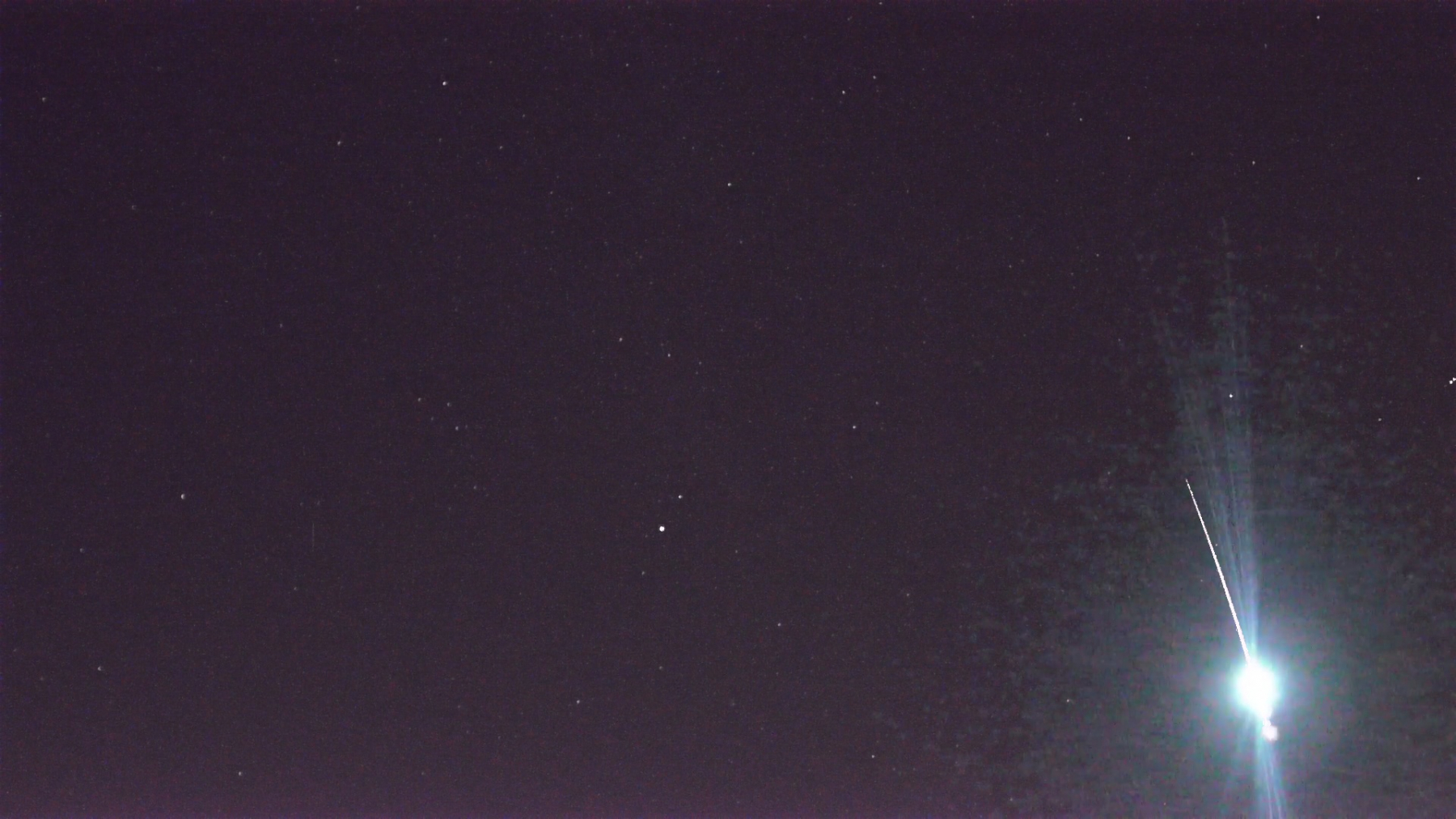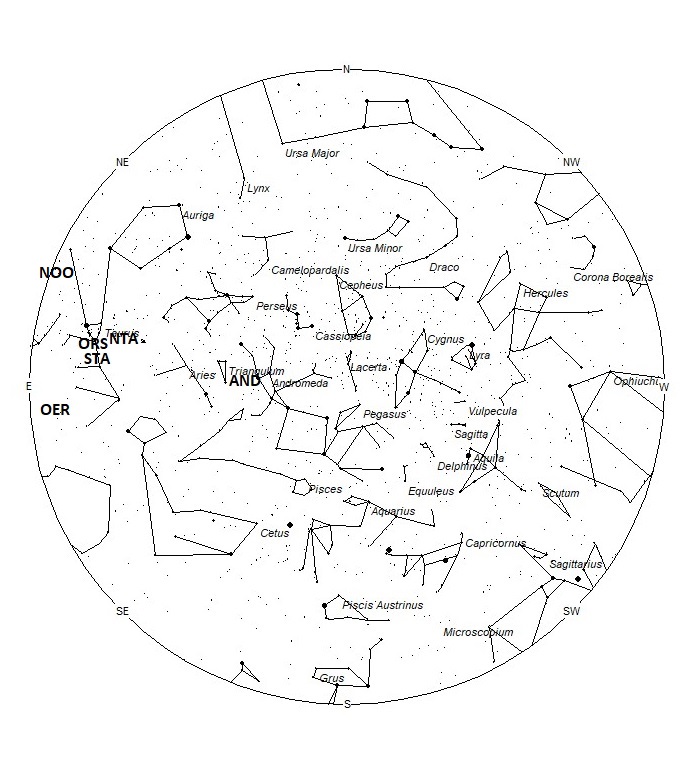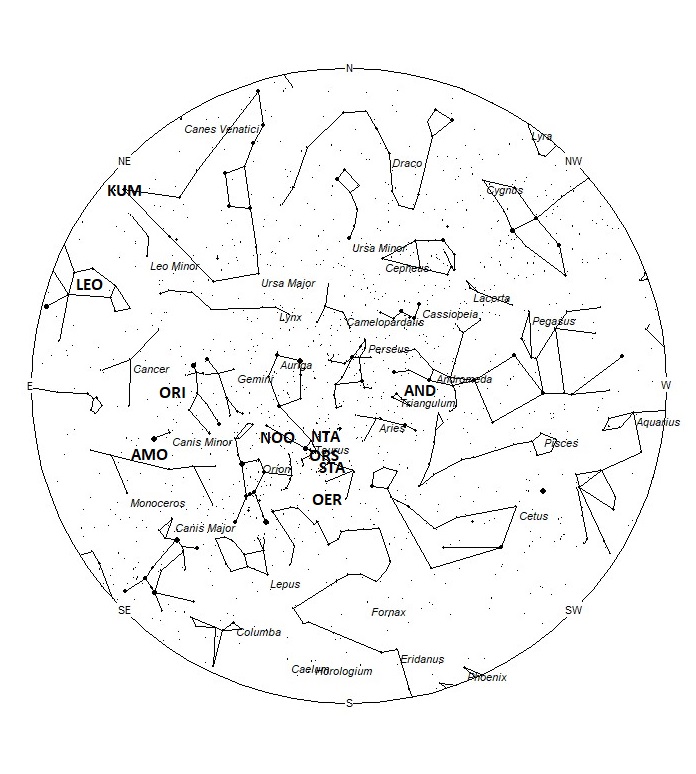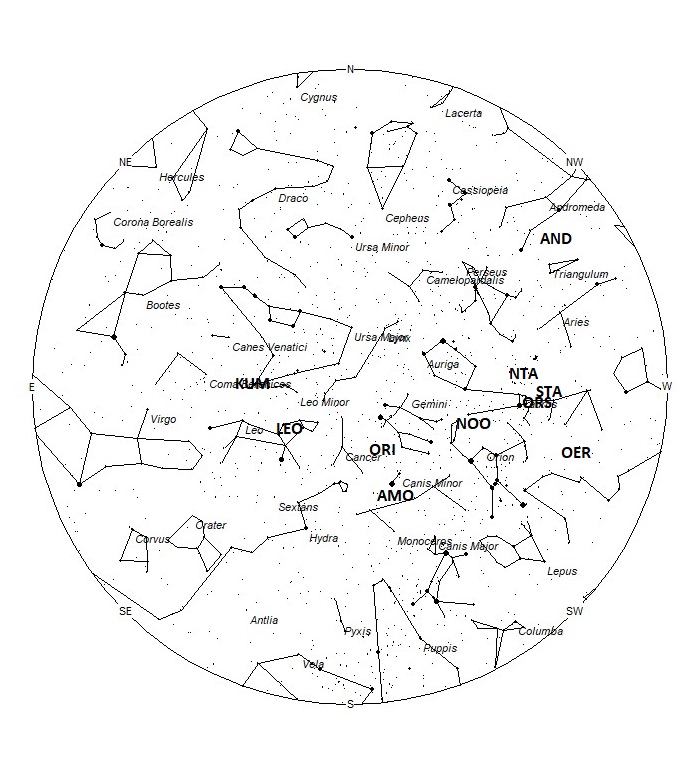 Jordan Ragsdale captured this fireball on 31 August 2021 at 22:27 MDT (04:27UT 1 Sep.), from Eagle, Idaho, USA using an AMS AllSkyCam (https://www.allskycams.com/) . ©Jordan Ragsdale
Jordan Ragsdale captured this fireball on 31 August 2021 at 22:27 MDT (04:27UT 1 Sep.), from Eagle, Idaho, USA using an AMS AllSkyCam (https://www.allskycams.com/) . ©Jordan RagsdaleDuring this period, the moon reaches its full phase on Friday November 19th. At that time the moon lies opposite the sun and remains above the horizon all night long. This weekend the waxing gibbous moon will set during the early morning hours, allowing a few hours of observing between moonset and dawn. The estimated total hourly meteor rates for evening observers this week is near 4 as seen from mid-northern latitudes (45N) and 3 as seen from tropical southern locations (25S). For morning observers, the estimated total hourly rates should be near 20 as seen from mid-northern latitudes (45N) and 13 as seen from tropical southern locations (25S). The actual rates will also depend on factors such as personal light and motion perception, local weather conditions, alertness, and experience in watching meteor activity. Evening rates during this period are reduced due to moonlight. Note that the hourly rates listed below are estimates as viewed from dark sky sites away from urban light sources. Observers viewing from urban areas will see less activity as only the brighter meteors will be visible from such locations.
The radiant (the area of the sky where meteors appear to shoot from) positions and rates listed below are exact for Saturday night/Sunday morning November 13/14. These positions do not change greatly day to day so the listed coordinates may be used during this entire period. Most star atlases (available at science stores and planetariums) will provide maps with grid lines of the celestial coordinates so that you may find out exactly where these positions are located in the sky. I have also included charts of the sky that display the radiant positions for evening, midnight, and morning. The center of each chart is the sky directly overhead at the appropriate hour. These charts are oriented for facing south but can be used for any direction by rotating the charts to the desired direction. A planisphere or computer planetarium program is also useful in showing the sky at any time of night on any date of the year. Activity from each radiant is best seen when it is positioned highest in the sky, either due north or south along the meridian, depending on your latitude. It must be remembered that meteor activity is rarely seen at the radiant position. Rather they shoot outwards from the radiant, so it is best to center your field of view so that the radiant lies at the edge and not the center. Viewing there will allow you to easily trace the path of each meteor back to the radiant (if it is a shower member) or in another direction if it is sporadic. Meteor activity is not seen from radiants that are located far below the horizon. The positions below are listed in a west to east manner in order of right ascension (celestial longitude). The positions listed first are located further west therefore are accessible earlier in the night while those listed further down the list rise later in the night.
These sources of meteoric activity are expected to be active this week.
.
The Andromedids (AND) are the annual debris encountered from the remains of comet 3D/Biela. These meteors should not be mistaken for the great meteor storms of the 19th century as those meteors are in a slightly different orbit and irregularly encountered in early December. They are known as the December phi Cassiopeiids (DPC). It is interesting that during November, this radiant moves northward toward the area of the DPC’s but ends before reaching the DPC radiant. The radiant currently is located near 01:31 (023) +33. This position lies in northern Pisces, 4 degrees southeast of the 2nd magnitude star known as Mirach (beta Andromedae). This part of the sky is best placed near 2200 local standard time (LST), when the radiant lies highest above the horizon. Current rates would most likely be less than 1 per hour no matter your location. With an entry velocity of 17 km/sec., the average Andromedid meteor would be of very slow velocity.
The Southern Taurids (STA) are active from a large radiant is located at 03:55 (59) +15. This area of the sky is located in western Taurus, 5 degrees west of the 4th magnitude star known as gamma Tauri. This radiant is best placed near 0100 LST, when it lies on the meridian and is located highest in the sky. Current rates should be near 3 per hour no matter your location. With an entry velocity of 25 km/sec., the average STA meteor would be of medium-slow velocity.
The omicron Eridanids (OER) was discovered by the Japanese video meteor network SonotaCo from video data obtained during 2007-2008. These meteors are active from October 23 through December 2nd. Maximum activity is ill-defined and may occur anytime from November 3-27. The date listed in the table represents the midpoint of the activity curve and not the actual date of maximum activity. The radiant is currently located at 03:57 (59) -01, which is located in northeastern Eridanus, 7 degrees south of the 4th magnitude star known as nu Tauri. This radiant is best placed near 0100 local standard time (LST), when it lies on the meridian and is located highest in the sky. Rates at this time should be less than 1 per hour no matter your location. With an entry velocity of 27 km/sec., the average OER meteor would be of medium-slow velocity.
The Northern Taurids (NTA) are active from a large radiant is located at 04:01 (60) +23. This area of the sky is located in western Taurus, 3 degrees southeast of the naked eye star cluster known as the Pleiades. This radiant is best placed near 0100 LST, when it lies on the meridian and is located highest in the sky. Rates at this time should be 4 per hour as seen from the Northern Hemisphere and 3 per as seen from south of the equator. With an entry velocity of 27 km/sec., the average NTA meteor would be of medium-slow velocity.
The Southern chi Orionids (ORS) are usually included in the totals of the Southern Taurids, as the two radiants are separated by only 5 degrees. Careful study of this area of the sky can separate these two showers. These meteors are active from November 14 through December 16, with maximum activity occurring on December 2nd. The radiant is currently located at 04:17 (64) +17, which lies in central Taurus, only 1 degree west of the 4th magnitude star known as Prima Hyadum (gamma Tauri A). This radiant is best placed near 0100 LST, when it lies on the meridian and is located highest in the sky. Rates at this time should be less than 1 per hour no matter your location. With an entry velocity of 28 km/sec., the average ORS meteor would be of medium-slow velocity.
The November Orionids (NOO) are active from November 13 through December 12, with maximum activity occurring on November 30th. The radiant is currently located at 05:19 (080) +16. This area of the sky lies on the Taurus/Orion border, 10 degrees north of the 2nd magnitude star known as Bellatrix (gamma Orionis). This radiant is best placed in the sky near 0300 LST, when it lies highest above the horizon. Rates should be less than 1 per hour no matter your location. With an entry velocity of 45 km/sec., most activity from this radiant would be of medium speed.
The alpha Monocerotids (AMO) are best known for their occasional outbursts, the last which occurred in 2019. These meteors are active from 13-27 November with maximum occurring on 22 November. Rates away from the night of maximum are very low, far less than 1 per hour no matter your location. The radiant is currently located at 07:30 (113) +00. This area of the sky is located in southern Canis Minor, 6 degrees southwest of the zero-magnitude star known as Procyon (alpha Canis Minoris A). With an entry velocity of 61km/sec, most of these meteors would appear swift.
The Orionids (ORI) are active from September 26 through November 22, with maximum activity occurring on October 21st. The radiant is currently located at 07:34 (113) +16, which places it in southeastern Gemini, half-way between the bright stars Procyon (alpha Canis Mainoris) and Pollux (beta Geminorum). This area of the sky is best placed near 04:00 LST. Current rates are expected to be near 1 per hour, no matter your location. With an entry velocity of 64 km/sec., the average ORI meteor would be of swift velocity.
The Leonids (LEO) are active from November 03-December 02 with maximum activity occurring on November 18th. The radiant is currently located at 10:07 (152) +23. This position lies in western Leo.2 degrees west of the 3rd magnitude star known as Adhafera (zeta Leonis). The Leonid radiant is best placed during the last hour before morning twilight when the radiant lies highest in a dark sky. Leonids may be seen from the Southern Hemisphere, but the viewing conditions are not quite as favorable as those north of the equator. Current rates are expected to be near 1 per hour as seen from the Northern Hemisphere and less than 1 as seen from south of the equator. With an entry velocity of 69 km/sec., most activity from this radiant would be of swift speed with numerous persistent trains on the brighter meteors.
The kappa Ursae Majorids (KUM) were discovered by cameras of the SonotaCo network in Japan during an outburst of activity on November 5, 2009. This radiant is active from October 28-November 17, with maximum activity occurring on the 5th. The radiant is currently located at 10:15 (154) +43. This position lies in southern Ursa Majoris, near the spot occupied by the 3rd magnitude star known as lambda Ursae Majoris. Rates are expected to be less than 1 regardless of your location. These meteors are best seen during the last hour before dawn when the radiant lies highest above the horizon in a dark sky. With an entry velocity of 63 km/sec., the average Kappa Ursae Majorid meteor would be of swift velocity.
As seen from the mid-northern hemisphere (45N) one would expect to see approximately 11 sporadic meteors per hour during the last hour before dawn as seen from rural observing sites. Evening rates would be near 3 per hour. As seen from the tropical southern latitudes (25S), morning rates would be near 7 per hour as seen from rural observing sites and 2 per hour during the evening hours. Locations between these two extremes would see activity between the listed figures. Evening rates are reduced by moonlight.
You can keep track of the activity of these meteor showers as well as those beyond the limits of visual observing by visiting the NASA Meteor Shower Portal available at: https://meteorshowers.seti.org/ You can move the sky globe to see different areas of the sky. Colored dots indicate shower meteors while white dots indicate sporadic (random) activity. The large orange disk indicates the position of the sun so little activity will be seen in that area of the sky.
| SHOWER | DATE OF MAXIMUM ACTIVITY | CELESTIAL POSITION | ENTRY VELOCITY | CULMINATION | HOURLY RATE | CLASS |
| RA (RA in Deg.) DEC | Km/Sec | Local Standard Time | North-South | |||
| Andromedids (AND) | Nov 06 | 01:31 (023) +33 | 17 | 22:00 | <1 – <1 | IV |
| Southern Taurids (STA) | Nov 05 | 03:55 (59) +15 | 25 | 01:00 | 3 – 3 | II |
| omicron Eridanids (OER) | Nov 13 | 03:57 (59) -01 | 27 | 01:00 | <1 – <1 | IV |
| Northern Taurids (NTA) | Nov 12 | 04:01 (60) +23 | 27 | 01:00 | 4 – 3 | II |
| Southern chi Orionids (ORS) | Dec 02 | 04:17 (64) +17 | 28 | 02:00 | <1 – <1 | IV |
| November Orionids (NOO) | Nov 30 | 05:19 (080) +16 | 45 | 03:00 | <1 – <1 | II |
| alpha Monocerotids (AMO) | Nov 22 | 07:30 (113) +00 | 61 | 05:00 | 1 – <1 | II |
| Orionids (ORI) | Oct 21 | 07:34 (113) +16 | 64 | 05:00 | 1 – <1 | II |
| Leonids (LEO) | Nov 18 | 10:07 (152) +23 | 69 | 07:00 | 1 – <1 | I |
| kappa Ursae Majorids (KUM) | Nov 05 | 10:15 (154) +43 | 63 | 07:00 | <1 – <1 | IV |
 American Meteor Society
American Meteor Society



Did anyone else view 4 bright lights November 11, 2021 in the Utah western sky? About 4:15 p.m. I noticed 4 bright objects (?) with a comet-like tail (definitely not a jet’s vapor trail) in the daytime lighted sky. They were visible for at least 20 minutes, moving northwest to southwest; viewing location Cedar City Utah. My grandson yelled, “Look! There are asteroids or comets or meteors….or SOMETHING!
My gf and I saw what we thought was a ufo fly about 500-700 feet over Stamford headed towards NYC at 4:30pm Nov 13th Today. Might have been a meteor Bc the colors we saw were insane behind it. Sparkling blue, pink and white.
I was on a date on the night of November 14, 7:47pm PST, and on the drive home (south bound), on the freeway we both saw what must have been a shooting star falling diagonally downwards. It only lasted for a split second, but it had a tail too, it was really interesting.
Wed morning 0555 EST just outside the 2 stars that form the bowl of the big dipper I saw 16 meteors in 30 seconds 1 after another. I believe there was more as I was 1st looking over to the Orion area and I believe saw saw action with my peripherial vision. It was great, This was seen just outside Orlando Florida
Raymond and All,
Your sighting sounds more like an appearance of StarLink satellites than meteors, especially since they were “one after another”. Meteors just don’t behave in this manner. They are totally random in timing and direction.
Saw a bright meteor low in the North Eastern sky at 4:30 AM on November 18th. I live in Central VA Piedmont..